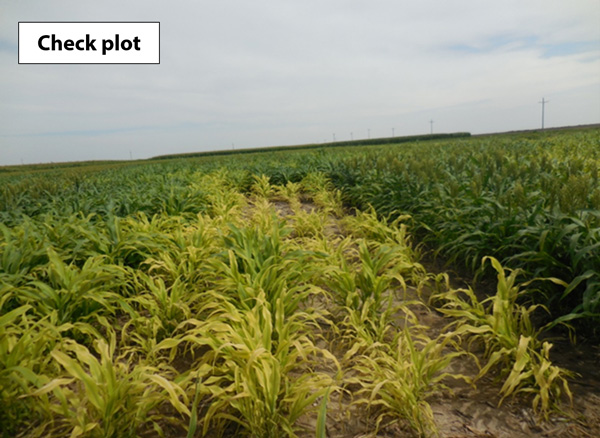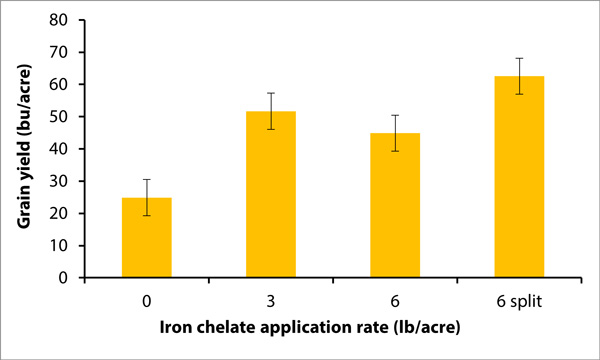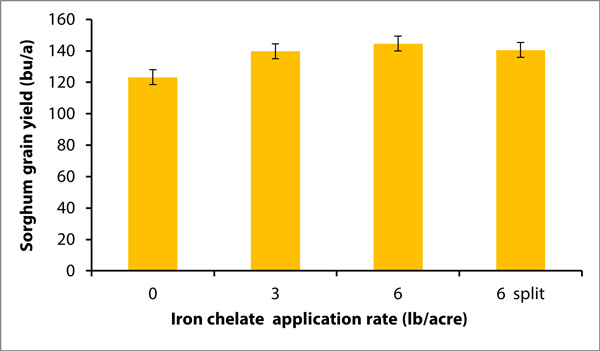Sorghum is a drought-tolerant crop well-suited for dryland and rain-fed cropping systems in Kansas. However, both grain and forage sorghum are highly susceptible to iron (Fe) deficiency chlorosis (IDC) when grown on high pH or calcareous soils. Iron is a catalyst needed for chlorophyll formation and photosynthesis to ensure optimal plant growth and development. Limited supply of Fe results in IDC with delayed crop maturity and reduced yields in susceptible grain sorghum hybrids. Iron is an immobile nutrient in plants, so IDC symptoms appear first on younger leaves with yellow streaks in the interveinal tissue, leaf tips, and margins. In severe conditions, younger leaves may turn pale green to bleached white. In typical sorghum fields, IDC development is non-uniform because soil chemical conditions vary across the field.
Causes of iron deficiency chlorosis
High soil pH, free calcium carbonate associated with calcareous soils, and low soil organic matter content are the major soil factors that reduce Fe availability. For instance, the solubility of Fe decreases when soil pH is greater than 7 because of the conversion of the ionic form of Fe to metal oxides or hydroxides that are relatively insoluble. High bicarbonates create alkaline soil conditions that affect the reduction of ferric form (Fe3+) to ferrous form (Fe2+) required for plant uptake and utilization.
Soils with less than 2.5 ppm DTPA-extractable Fe concentration are considered deficient and could result in IDC. Soil nutrient interactions can also result in IDC. High P concentrations in sorghum tissue can induce Fe chlorosis because of immobilization of Fe in the leaves. While manure application can supply nutrients, including Fe, manure containing high P concentrations and carbonates can interfere with Fe availability and uptake. High levels of soil nitrate can also induce IDC. When plants take up nitrate (NO3-), they release bicarbonate ions (HCO3-) into the root zone. The release of bicarbonates in exchange for nitrate uptake inhibits the conversion of Fe3+ to Fe2+ in the plant, resulting in iron chlorosis. Application of ammonium-based fertilizers can enhance Fe availability and uptake due to a reduction in pH near the root zone.
Environmental conditions such as low temperature and drought can reduce root growth, increase bicarbonate levels, and reduce Fe availability.
Managing iron deficiency in sorghum fields
Since IDC can vary significantly over time and within the same field, this complicates managing IDC. In mild chlorotic conditions, sorghum can grow out of IDC over the growing season when adequate moisture is available.
An effective management strategy for preventing IDC in grain sorghum should be a comprehensive approach that considers field history, application of Fe chelates, and selection of IDC-tolerant sorghum hybrids. The application of iron sulfate is not very effective because it quickly reacts with carbonates and becomes unavailable.
There are several Fe chelate products, including Fe-EDTA, Fe-HEDTA, Fe-DTPA, and Fe EDDHA, marketed to treat iron deficiency. However, not all chelate products are effective at pH > 7.5. The Fe-EDDHA forms are more effective in controlling IDC on high pH (> 7.5) soils.
K-State research on managing IDC in grain sorghum
We conducted field experiments in 2015-2016 to test iron chelate application in alleviating IDC in grain sorghum under both dryland and irrigation conditions in western Kansas. Treatments were Fe-EDDHA (6% Fe) application rates (0, 3, and 6 lb product/acre, and split application of 3 lb/acre applied at planting and another 3 lb/acre applied 2 weeks after planting). The treatments were applied to five commercial sorghum hybrids (two susceptible and three IDC-tolerant hybrids) as sub-plots. The Fe chelate was applied in-furrow at planting, except for the split treatment, where the chelate was applied at planting, plus an additional Fe chelate application 2 weeks after planting. Soil pH at the Tribune site was 7.9 and 8.0 near Garden City. The calcium carbonate equivalent of the soil varied from 2.5% at the SWREC in Garden City, 8.2% at the producer field near Garden City, and 8.6% at the SWREC near Tribune.
Results showed grain sorghum hybrids differed in tolerance to iron chlorosis. In general, the severity of iron chlorosis was less in tolerant sorghum hybrids and more severe in the two susceptible hybrids, regardless of location.
Severity of IDC scores decreased as the growing season progressed at SWREC at Garden City and at Tribune (under irrigation) but not in the producer’s field near Garden City. The greater severity of IDC at the producer’s farm was due to high carbonate concentrations in the soil and drought conditions.
Iron chelate application suppressed IDC in the susceptible hybrids at both the dryland and irrigated locations (Figure 1). Even in tolerant hybrids, applying 3lb/acre Fe chelate product improves growth and development (early flowering) compared to the control.
Grain yields were different among the sorghum hybrids at both dryland and irrigated sites. Applying 3 lb/acre Fe chelate increased sorghum grain yield by 27 bu/acre and 17 bu/acre compared to the control at both dryland sites near Garden City and the irrigated site near Tribune (Figure 2).
In another study, foliar application of 3 lb/acre Fe chelate to sorghum at the three-leaf stage was as effective as in-furrow application at planting. In that example, grain sorghum yield with the control treatment was 89 bu/acre, 101 bu/acre with in-furrow application compared to 107 bu/acre with the foliar application treatment. Details of past K-state research on managing iron chlorosis on sorghum can be found in this report: https://newprairiepress.org/cgi/viewcontent.cgi?article=1236&context=kaesrr.
Other studies have shown that seed treatment with Fe-EDDHA can be effective at controlling IDC. Soil amendments with manure or pelleted manure can alleviate IDC on eroded soils with low soil organic matter content.
Applying acidifying soil amendments such as sulfur, sulfuric acid, or Fe pyrites is not feasible on a field scale because large amounts will be required to lower soil pH.
Limited trials have been conducted evaluating dry humic acid products for alleviating IDC. Four trials were conducted in Wallace and Thomas Counties in 2016. Both raw chipped dry humate (72% humic acid) and a granular prilled product (70% humic acid) were applied in-furrow, in 30-inch rows with the seed at 6 different rates. Rates evaluated were 0-70 lb/ac for the raw chipped product and 0-35 lb/ac for the granular product. Chlorosis was observed at the sites; however, no treatment differences were observed in visual rating, GreenSeeker NDVI measurement, or final grain yield. Further work is needed on this topic.


Figure 1. Application of Fe chelate suppressed IDC in susceptible hybrids. The control treatment (top) and a plot that received 3 lb/a Fe chelate (bottom) show the difference between treatments. Photos were taken on August 4, 2015 (60 days after planting near Tribune, KS).


Figure 2. Sorghum grain yield as affected by iron chelate application across two dryland locations near Garden City, KS (top graph) and an irrigated location near Tribune, KS (bottom graph).
Summary of key points
- Planting IDC-tolerant sorghum hybrids is the most cost-effective strategy to managing iron deficiency.
- Apply Fe chelate in-furrow at sorghum planting in fields with known history of iron chlorosis to reduce IDC.
- High soil nitrates and P concentrations can exacerbate IDC in sorghum fields.
- Manure application can reduce IDC in fields with low soil organic matter content. However, manure containing high levels of P and carbonates can reduce Fe uptake.
Augustine Obour, Soil Scientist
aobour@ksu.edu
Dorivar Ruiz Diaz, Nutrient Management Specialist
ruizdiaz@ksu.edu
John Holman, Cropping Systems Agronomist
Jholman@ksu.edu
Lucas Haag, Northwest Area Agronomist
lhaag@ksu.edu
Tags: sorghum grain sorghum soil fertility chlorosis iron deficiency